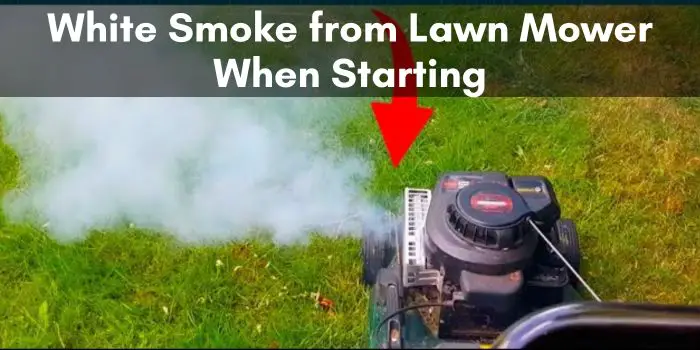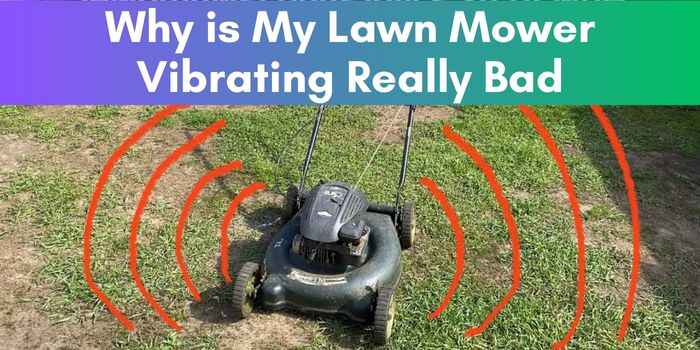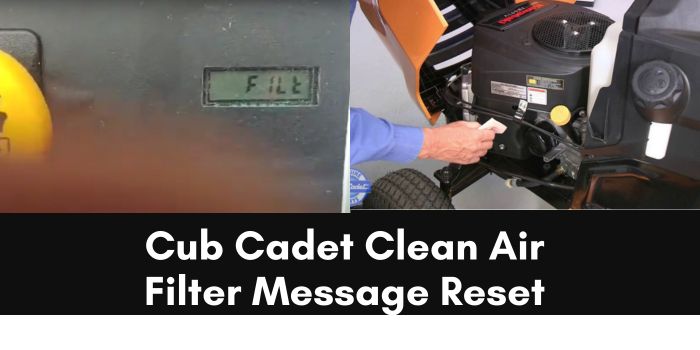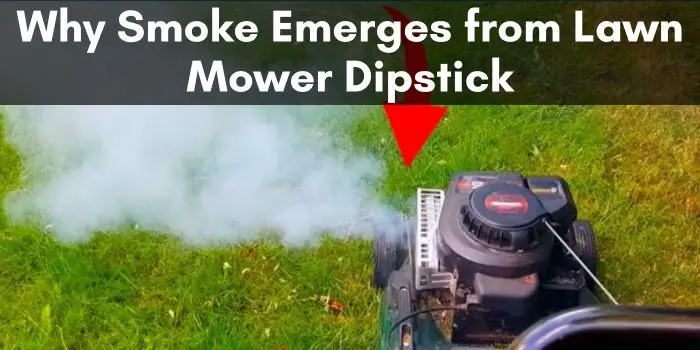White Smoke from Lawn Mower When Starting: Quick Fixes!
White smoke from a lawn mower upon starting commonly indicates burning oil. A tipped-over mower or an overfilled oil reservoir are frequent causes.
Starting your lawn mower only to observe a puff of white smoke can be alarming. Often, this issue is benign and resolves quickly, especially if the lawn mower was recently stored on its side or the engine oil chamber was filled beyond its capacity, causing oil to seep into the combustion chamber.
Proper lawn mower maintenance is essential to prevent this occurrence, including regular oil checks and understanding the equipment’s orientation limits.
Keeping a close eye on the oil level and refraining from tilting the lawn mower excessively can help avoid the white smoke issue.
Moreover, addressing this promptly ensures the longevity and effectiveness of your gardening tool, keeping your lawn in pristine condition.
White Smoke Panic: Decoding The Signals
Starting your lawn mower should be the beginning of a productive day in the garden. But white smoke billowing from your mower can cause instant worry.
Let’s know what your mower is trying to tell you, dispelling the “white smoke panic” with some easy-to-understand signals.
The Colors Of Smoke And What They Mean
Smoke from your lawn mower is like a secret language about its health. Not all smoke signals spell trouble.
Here’s what different smoke colors may indicate:
- White Smoke: Often just condensation burning off.
- Blue or Gray Smoke: This could mean oil is burning.
- Black Smoke: Usually a sign of an overly rich fuel mix.
Interpreting White Smoke: Is It Always A Sign Of Trouble?
White smoke might not mean big problems. It’s important to consider when and how much smoke you see.
Here’s a quick guide:
| When You See White Smoke | Possible Reason |
|---|---|
| At Startup | Condensation burning off. |
| During Use | Oil spill on the engine. |
| Constantly | Possible oil leak into the engine. |
Remember, an occasional puff of white smoke is usually harmless. Constant, thick smoke, on the other hand, may require a professional’s touch.
Common Causes Of White Smoke
White smoke billowing from a lawn mower can be startling. Thankfully, the phenomenon often links back to a few, common issues. Identifying these culprits ensures a quicker return to a healthy, smoothly running lawn mower.
Oil Overfill Issues
Putting too much oil in your lawn mower may lead to white smoke. It’s essential to check the oil level before starting your mower, using the dipstick.
To resolve an overfill:
- Turn off the mower and let it cool.
- Drain excess oil until the dipstick shows the correct level.
- Restart the mower and observe for any smoke.
Head Gasket Mishaps
A damaged head gasket can let oil leak into the combustion chamber. This issue creates white smoke.
Signs include:
- Oil outside the engine block.
- Lawn mower losing power.
A professional may need to replace the gasket for you.
Condensation Culprits
After long periods of non-use, condensation can build up in the fuel system. This typically resolves as the engine warms up.
Quick tips are:
- Let the mower run for a few minutes.
- If smoke persists, check the oil and gasket condition.
Initial Diagnosis Steps
Seeing white smoke from a lawn mower can surprise anyone. It often means it’s time for a quick check-up.
Knowing a few steps can help you figure out the problem fast. Here’s how to get started with diagnosing the issue.
Visual Inspection Basics
A good look at your lawn mower can tell you a lot. Check for any loose parts or damage. Make sure nothing blocks the exhaust. Look carefully for leaks or unusual signs on the mower.
Checking The Oil Level
Oil keeps the engine running smoothly. A low level might cause white smoke. Use the dipstick to check oil levels. Wipe it clean, insert it fully, then pull it out. The oil should be between the marks.
Here’s how:
- Find the oil dipstick and remove it.
- Clean the dipstick with a cloth.
- Put it all the way in, then pull out to check.
- See if the oil is in the safe zone.
Examining The Muffler
The muffler handles exhaust. It can cause white smoke if not working right. Check for soot or oil on it. Make sure it is not damaged. A clean muffler means a happy mower engine.
| Check Point | What to Look For | What It Means |
|---|---|---|
| Muffler Exterior | Soot, Oil Residue | Possible clogs or leaks |
| Muffler Condition | Dents, Holes, Rust | Damage may affect performance |
By following these steps, you can start to understand why your lawn mower might be producing white smoke when you start it.
Quick Fix Strategies
Seeing white smoke puff from a lawn mower upon starting can be alarming. Relax, it’s often a minor issue. Quick fix strategies can help address the problem. Read on for simple solutions to get back to mowing.
Regulating Oil Levels
Too much oil in your lawn mower can cause white smoke. A quick check of the oil dipstick tells you the level. If it’s too high, drain the excess to the recommended level. This table outlines the steps:
| Step | Action |
|---|---|
| 1 | Locate the oil dipstick |
| 2 | Check oil level |
| 3 | Drain excess if needed |
Remember to use the right type of oil for your mower next time.
Tackling Condensation
Condensation in the mower’s system might cause white smoke. To clear it out, run the mower for a few minutes. This lets the engine heat up and evaporate moisture.
Follow these steps:
- Start the mower safely.
- Let it run for about 5 to 10 minutes.
- Watch the smoke vanish as the engine warms.
The Temporary Run
Sometimes, a simple run is all you need. If the mower was tipped or the oil was overfilled, let it run. Keep an eye on the smoke:
- Start the mower safely.
- Monitor as the white smoke appears.
- Allow the mower to run; it often clears up within minutes.
If white smoke persists, stop the engine. It’s best to consult a professional.
Preventive Maintenance Tips
Witnessing white smoke from a lawn mower upon startup often rings alarm bells for garden enthusiasts. It signals a need for immediate attention and preventive maintenance.
Staying ahead with a proper care routine not only saves you from future hassles but also ensures your mower operates efficiently. Discover the essential tips to keep your lawn mower in pristine condition.
Routine Lawn Mower Care
Regular attention is the key to a long-lasting lawn mower.
Here are steps to follow:
- Check the blade’s sharpness. A dull blade rips grass, causing harm over time.
- Clean the undercarriage. Remove grass clippings to prevent clogging.
- Inspect the air filter. A clean filter ensures optimal engine performance.
- Replace spark plugs annually for consistent starting and running.
- Keep nuts and bolts tight to avoid vibration damage while mowing.
Proper Oil Management
Correct oil levels and quality are vital for mower health. Keep these points in mind:
- Use the correct oil type specified by your mower manufacturer.
- Check oil level before each use; fill if it’s low.
- Change oil after every 50 hours of use or at least once per season.
- Dispose of old oil responsibly to protect the environment.
Seasonal Storage Guidelines
Proper storage safeguards your mower during off-seasons.
Follow these guidelines:
| Storage Step | Action Item |
|---|---|
| Clean the mower | Remove dirt and debris to prevent decay. |
| Drain fuel | Empty or add a stabilizer to the tank to prevent gumming. |
| Remove the battery | Store in a cool, dry place to extend its life. |
| Cover the mower | Use a breathable cover to protect from dust and moisture. |
When To Call The Pros
Spotting white smoke billowing from a lawn mower can turn a peaceful day of yard work into a stressful troubleshooting mission.
While a few puffs of smoke might not be a dire issue, recurring or heavy smoke signals a time to seek expert help.
Understanding when it’s necessary to call in the professionals can save both your lawn mower and your peace of mind.
Persistent White Smoke Woes
If white smoke continues after the initial startup, it’s important to consult a professional. Here’s when pro assistance becomes crucial:
- Oil level doesn’t decline: If checking the oil shows a constant level, the mower may have a more serious problem.
- Smoke lasts beyond warm-up: Smoke should decrease as the engine warms, persistent smoke is troublesome.
- Strange engine noises: Knocking or rattling sounds paired with smoke require urgent attention.
Complex Engine Issues
A do-it-yourself approach might fix simple problems, but complex engine issues often hide beyond the reach of basic tools and knowledge.
Components like the head gasket, piston rings, or cylinder block may fail and cause white smoke. Pros have the tools and expertise to diagnose these issues swiftly and accurately.
Warranty And Professional Service Considerations
If your lawn mower is still under warranty, attempting repairs yourself could void the warranty.
Always review warranty terms and prefer professional service to maintain coverage. This can include:
| Action | Benefit |
|---|---|
| Authorized Service | Upholds Warranty |
| Expert Assessment | Accurate Diagnosis |
| Genuine Parts | Reliable Repairs |
Understanding The Risks
When a lawn mower emits white smoke during start-up, it’s crucial to assess the risks. White smoke often indicates burning oil, which could harm the engine if ignored.
Addressing this issue swiftly can save money and prevent further damage to the lawn mower.
Let’s dive into the potential problems and financial consequences of overlooking this sign.
Potential Engine Damage
White smoke may signify serious engine issues. Here’s what could be happening:
- Oil Overflow: Excessive oil can seep into the combustion chamber.
- Seal Problems: Damaged seals and gaskets might let oil leak into the engine.
- Head Gasket Failure: A broken head gasket can mix oil and fuel, causing smoke.
Fixing engine damage early can avoid expensive repairs and extend mower life.
Ignoring The Warning Signs
Dismissing white smoke can lead to worse problems. Continued usage without checks can result in:
- Permanent engine damage.
- Loss of power and efficiency.
- Complete engine failure.
Regular maintenance is crucial to keep your lawn mower running smoothly.
Cost Implications Of Neglect
Avoiding early repair can be costly. Consider the following:
| Issue | Short-Term Cost ($) | Long-Term Cost ($) |
|---|---|---|
| Gasket Replacement | 50-150 | <500 |
| Engine Overhaul | 500-1000 | 1000+ |
Investing in timely fixes prevents steep future expenses. Regular maintenance checks identify small issues before they become big ones.
Future-proofing Your Lawn Mower
Future-proofing your lawn mower can save you from unexpected breakdowns. When you see white smoke, it’s warning you. Keep your mower fit for the future with smart upgrades and care.
Upgrading Mower Quality
Enhancing your mower’s quality means fewer smoke signals at start-up. Opt for mowers with advanced features. They last longer and perform better.
- Invest in models with robust engines and quality cutting blades.
- Look for mowers with easy maintenance designs.
- Choose a brand known for durability and reliability.
Investing In Regular Tune-ups
Regular tune-ups keep parts moving smoothly. They cut down on troublesome smoke. A well-serviced mower is a long-lasting mower.
| Tune-Up Task | Frequency |
|---|---|
| Change oil | Every 50 hours of use |
| Check air filter | Every 25 hours of use |
| Replace spark plugs | Once a season |
| Inspect blades | Every 100 hours of use |
The Importance Of Using Quality Fuels And Oils
Quality fuels and oils mean a cleaner burn. They protect engines from damage. Using the right products extends mower life.
- Select fuel with no ethanol to prevent moisture buildup.
- Use manufacturer-recommended oil grades for optimal performance.
- Avoid using old gas; keep fuel fresh and your mower happy.
Troubleshooting Techniques
Seeing white smoke from your lawn mower can be alarming. Don’t worry though, with the right troubleshooting techniques, you can pinpoint the problem.
These steps will guide you through the process. Follow them to get your mower running smoothly again.
Spark Plug Sleuthing
First, inspect the spark plug. A dirty or faulty spark plug often causes starting issues. Follow these steps:
- Turn off your mower and wait for it to cool.
- Remove the spark plug using a socket wrench.
- Check for soot, damage, or wear.
- Clean or replace it if needed.
Air Filter Assessment
Next, check the air filter. A clogged filter can cause smoke. Here’s what to do:
- Locate the air filter cover on the mower.
- Open it and take out the filter.
- Look for dirt or oil buildup.
- Clean it with warm soapy water or replace it.
Fuel System Check-up
Last, examine the fuel system. Bad fuel or a dirty carburetor can lead to smoke. Do the following:
| Step | Action |
|---|---|
| 1 | Ensure you have fresh fuel in the tank. |
| 2 | Remove the carburetor. |
| 3 | Clean it with carburetor cleaner. |
| 4 | Reassemble and test the mower. |
By following these troubleshooting steps, you’re on your way to a smoke-free start with your mower!
The Role Of Weather
Weather plays a crucial part in the performance of lawn mowers. Whether it’s a chilly morning or a humid day, the climate can impact how your machine starts and operates.
Understanding these reactions can help you troubleshoot and maintain your machine effectively.
Cold Start Challenges
Lawn mowers can balk on cold mornings. Just like us, they need to warm up. Oil thickens from low temperatures, making the engine harder to turn over.
This often causes white smoke as the mower works through the initial resistance.
- Preventative measures include using the correct oil viscosity.
- Seasonal maintenance is key.
- Gentle warm-up practices help avoid stress to engine parts.
Humidity And Lawn Mower Health
Humid air can affect your mower’s health. Moisture in the air combines with fuel, causing incomplete combustion. This results in white smoke. Keeping your mower dry and clean is essential.
- Store your lawn mower in a dry place.
- Avoid cutting wet grass.
- Check air filters regularly to maintain airflow.
Dealing With Dampness
Damp environments can lead to condensation within the engine or fuel system. This results in white smoke on startup.
Protecting your mower from these elements helps prevent issues.
| Action | Benefit |
|---|---|
| Cover your mower | Keeps it dry |
| Use fuel stabilizer | Minimizes moisture-related problems |
| Regular engine checks | Ensures early detection of moisture buildup |
By acknowledging the role of weather, you can ensure your lawn mower operates smoothly with minimal hiccups, no matter the climate.
Wrapping Up: White Smoke Warnings
Seeing white smoke when starting a lawn mower can be alarming. White smoke usually indicates something isn’t quite right within your mower’s engine or oil systems.
But don’t panic; understanding the reasons behind the smoke is your first step towards a solution. This section recaps potential fixes and preventive measures to keep your mower running smoke-free.
Summarizing The Solutions
The appearance of white smoke often points to a few common issues. Overfilling the oil, a tipped-over mower, or a faulty head gasket rank high on the list of culprits.
Let’s break these down:
- Check the oil level: Ensure it’s not above the maximum mark.
- Return to upright: If tipped, keep the mower level for a while before restarting.
- Inspect the gasket: Look for signs of wear or damage and replace if necessary.
Embracing Regular Maintenance
Mower care helps prevent unexpected issues. Regular checks and cleaning go a long way. Make maintenance a routine:
- Clean or replace air filters.
- Change the oil according to the manufacturer’s schedule.
- Keep blades sharp and balanced.
Recognizing The Signs Of A Healthy Lawn Mower
A healthy mower makes lawn care a breeze. Remember these signs:
| Sign | Description |
|---|---|
| Smooth Start | Mower starts quickly without excess smoke or noise. |
| Consistent Performance | Engine runs steady and cuts grass evenly. |
| No Smoke | Exhaust is clear, showing efficient engine function. |
Frequently Asked Questions
What Causes White Smoke From Briggs And Stratton Engine?
White smoke from a Briggs and Stratton engine usually indicates burning oil. Possible causes include overfilled oil, worn engine parts, or a leaking head gasket.
How Do I Get Excess Oil Out Of My Lawn Mower?
To remove excess oil from your lawn mower, begin by turning off the engine and let it cool. Next, detach the spark plug for safety. Tilt the mower on its side, ensuring the air filter faces upwards to prevent contamination.
Then, drain the excess oil into a suitable container. Dispose of the oil responsibly.
What Is White Smoke From Exhaust?
White smoke from an exhaust often indicates coolant entering the combustion chamber, usually due to a breached head gasket or cracked engine block. This should be inspected and repaired promptly to avoid engine damage.
Why Does My Lawn Mower Smell Like Burning?
A lawn mower may emit a burning smell due to an overheated motor, dull blades causing friction, or a jammed cutting deck. Regular maintenance can prevent these issues.
Conclusion
As we wrap up, remember that white smoke from your lawn mower is not uncommon. It often signals oil combustion or condensation.
Regular maintenance can prevent most issues. If the smoke persists, consult a professional. Keep your mower running smoothly for a lush, healthy lawn.







